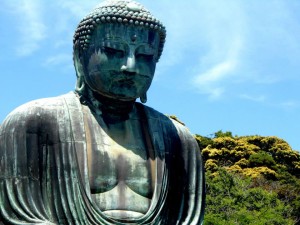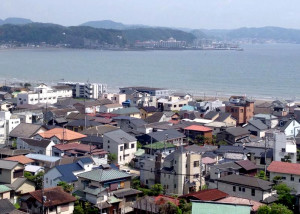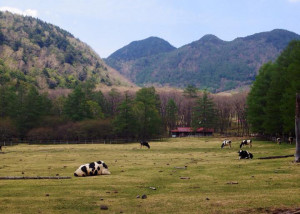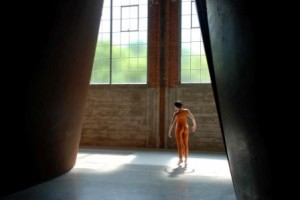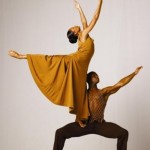Butoh, Explained
What is Butoh? In a word, dance-theater…
History of Butoh
Butoh began in 1960s Japan as a new dance-theater form created by collaborations between Tatsumi Hijikata and Kazuo Ohno. The inspiration for this new style was in part a reaction to post-war shock as well as the influx of western influence on Japanese dance, but also a desire to create something which differed from the strict, classical forms of Kabuki and Nōh theater. The two Kanji characters that form Butoh (舞踏) translate to dance and step, although it was originally called ankoku butoh (暗黒舞踏), ‘dance of darkness’. Because the term ‘butoh’ had traditionally been associated with Western or non-Japanese dance forms, this naming reversed expectations about the style and today butoh has come to be recognized as a one of uniquely Japanese origin.
The dance itself is difficult to define, as its founders were not teachers of a method, but commonly used are slow movements, white body paint, and grotesque or sexual imageries, in contrast to characteristics we in the West tend to take for granted as conventions of dance, such as meter determined by music, beauty of form, and immediate spectacle. Although spectacle may be a misleading word of contrast, as the excitement of Butoh often comes from its sheer attention to detail.
Here is a video of one of Butoh’s founders, Kazuo Ohno, performing a scene from his piece, ‘My Mother’.
https://youtu.be/V-roXj8UBIA
Here is another of Ko Murobushi, a student of other founding member Tatsumi Hijikata performing his piece ‘Ritournelle’ at the Latvian National Opera in 2014.
Note the often begrudging movements, contorted faces, and yet throughout the exact confidence of each motion. At first unsettling, then hypnotic and suddenly beautiful, this is how Butoh is formed.
Butoh and Sankai Juku
The troupe Sankai Juku was founded by Amagatsu Ushio in 1975, and since then has toured worldwide, playing at events such as the Nancy International Festival and Edinburgh Festival, and receiving honours such as the Grand Prix at the Belgrade International theater Festival (1982), 33rd Japanese Dance Critic Association Prize (2001), and Best New Dance Production of the 26th Laurence Olivier Awards (2002). Their special relationship with the renowned Théâtre de la Ville in Paris has resulted in the premiere of a new work every two years since 1982.

When asked what Butoh means to him, founder Ushio said:
“This may actually be closer to a definition of what creation is rather than what Butoh is, but after leaving Japan and looking at things anew, I became extremely conscious of the importance of what I call ‘difference and universality’ in culture.
As we toured the world performing, every city we went to was different in terms of language, food, daily life customs and all. We were drenched in a shower of differences almost every day. And in the process, I realized that culture exists exactly because of these differences. At the same time, on the other extreme there grew in me a heightened consciousness that there is a human “universality” that exists in all people, regardless of nationality or culture…Looking back now, I feel that those personal experiences of universality are the backbone that has enabled me to create and present my works to the world, or perhaps you could say they gave me the courage to work as I have.
Here is our Sankai Juku at Kitakyushu Performing Arts Center in 2015, premiering ‘MEGURI’ (山海塾). How varied, the execution of each performance, yet how similar their pull, this is how Butoh is performed.”
In the 2019/20 season, UMS presents “Meguri” in Sankai Juku’s sixth Ann Arbor performance on October 25-26, 2019 at the Power Center. Don’t miss this opportunity to see one of the dance world’s great jewels!
Watching Sankai Juku: How do we stay vulnerable to art?
Editor’s note: Russell Brakefield is a poet and one of our 2015-2016 artists in residence. As part of this program, artists in residence attend UMS performances to inspire new thinking and creative work within their own art forms. Russell saw Sankai Juku, the Japanese Butoh dance company. Below is his response to the performance.
In my writing life there are sometimes moments of terrible silence, moments where nothing comes. That old fear settles in—that I will never write another poem again. I tell my students that these moments pass. Stick with it, I say. Find a routine that works for you! Or I tell them to go out and experience other art. And alone in my office I try to reassure myself as well. I read. I go to the museum. I see a show. All things pass. This too.
But worse than this feeling of unproductivity is the occasional emotional silence that accompanies it, a feeling that I am unable to receive art, let alone make it. I feel, in these moments, as though my relationship to the world has been fractured. I stand before a gallery wall and tilt my head. I shuffle to the bar before the show ends. I leave stacks of books abandoned. In these moments, I can’t rightly see the world around me and therefore can’t carve out a place within it. I’m no longer capable of wielding the broad axe. But these are the bad times, and I’m often lifted from this watery stupor in surprising ways. As part of the UMS Artist in Residence program I recently attended Sankai Juku’s UMUSUNA: Memories Before History, and it pulled me up from underneath.
In the opening piece UMUSUNA, a single dancer works over the stage. He moves back towards a string of sand filtered through the ceiling. The music is subtle, arresting. The dancer’s limbs lift in a controlled strain. Two pans hang on each side of the stage, the stage itself then some sort of balance. Throughout the show the pans lift and sag—the themes of being and time hang delicately behind the dancers. The performance is punctured by movement. The dancers move slowly, sometimes so slow and with such rigidity that it is difficult to watch. But as the performance unfolded I found myself deeply engaged. The dancers pushed slowly through each piece, some barely lit, some blown through with primary color. One piece featured dancers gaping at the sky, their movements semi-synchronized. Another featured dancers in the fetal position and swaddled in white. Each body shifted and lurched on the stage like an ultrasound or an ex-ray of an egg. From my place in the audience I shifted as well and language uncorded suddenly inside my skull.

In her essay Goodbye to All That, Joan Didion talks about being young and therefore more open to emotional experience. “When you twenty-two or twenty-three,” she writes, “you figure that later you will have a high emotional balance, and be able to pay whatever it costs.” She is talking about New York City, standing on a corner eating a peach, falling in love with the smell of trash and lilacs. But somewhere beneath this is an argument that art too is best experienced by the young, the wild at heart. I don’t buy into the idea that art is best consumed by the young or—despite what pop music tells us—that the best living is done in our twenties. But I do wonder what the trick is to staying open in this way. How do we continue to experience art as though we are finding it for the first time? How do we, as another writer puts it, work to hold tight the basic truths we know? I often return to an image of my younger self devouring books in a university library, writing frantic verse. I’d never go back there, but I would give a lot to still feel that truth so well—that if I ever stopped writing I might cease to exist.
I’m embarrassingly uninformed about dance, but in preparation for the show I did some reading on Sankai Juku and Japanese Butoh. The internet told me that the term Butoh means “dance of darkness,” and I seemed to understand the essentials— avant-garde, slow movement, etc. But when the show started I was drawn intensely and immediately to the control of the moments on the stage, to the colors, to the stage setting. And the work seemed to correlate so directly with my own aspirations on the page as well. Later, scribbling at my desk, I would revel at the rigid, protracted movements I’d witnessed and how they seemed to implore a sense of torment, a disruption. I was enamored with the way the dancers enacted a sense of control and formal acuity while also attempting to disrupt, to deepen the resonance of the themes inherent in the show—origins, time, self, etc.
The poet Carl Phillips writes, “this resonance can be frustrating for the reader who wants experience to be translated; but poems tend to instead transform, not translate […] their business, as it were, is to transform experience so that our assumption about a given experience can be disturbed and, accordingly, our thinking about that experience might be at once made more complicated, deeper, richer.” UMUSUNA worked towards this type of transformation. Here language was the body, the bodies collapsing together in poem. Meaning was both separate from and dictated by form, afforded by form and challenged by it. I was encouraged by this performance to embrace form as an opening, as a sort of awakening, and a type of time travel. In the audience and after the show, I felt rattled. I felt in some small way that I was being re-formed from the pieces of the writer I had previously been. I felt bent back to the moments in my life where I was most vulnerable to art.

I read in the program, as the lights dimmed and the performance began, that UMUSUNA is a word that relates to one’s birth place. But more than that, the program reports, “Umusu embodies the concepts of everything and nothing, existence and nothingness. Na evokes the land, the ground/soil, and one’s native place.” I thought about where I come from. I thought about my native place in art, in life. As the single dancer from the first piece left the stage, the performance opened to a frantic second piece. A group of dancers spun across the sandy plates on stage, everything tinted red. The music raged. The dancers separated and linked up again. I leaned forward in my seat. In that moment I may not have been thinking of my work—of poetry or writing or form or influence—but I felt deeper parts of myself sliding open. I felt time go wobbly. I could say that it is simply through new experience that we awaken again and again to ourselves and our potential as artists. This show affirmed that for me, sure. But perhaps I will also be forced to reexamine my understanding of form and the role it should play in my writing. Maybe to push form to the forefront of the work and let subject and theme bow to it, maybe this can help unwrap the cold heart, tow out the muse from where its buried deep in that native place, keep us young, restore our faith.
Photos of Sankai Juku are courtesy of the artist.
Free Dance Workshops for All
Lots of happy faces at our You Can Dance workshop and Breakfast Download Discussion event this weekend.

Photos by Sharman Spieser.
Interested in more? See the full listing of upcoming free activities open to all levels.
You Can Dance: Sankai Juku
Did you know that you can join dancers from visiting companies for an exploration of the company’s movement style? These “You Can Dance” workshops are for everyone, no dance training or experience necessary. Ages 13 and up are welcome. The workshops are free, but first come, first served until studio reaches capacity. Last night, dancers from Sankai Juku led a workshop.
Workshop participant Sharman Spieser caught up with her fellow participants.
Megan and Lindsay drove from Detroit for the workshop.

We caught up with a few other participants on video.
First is Petra Kuppers, UMS Mellon Faculty Fellow and Professor of English Languages and Literatures, Women’s Studies, Art and Theatre. She is currently teaching a course on artistic collaboration at U-M, and her class will see the Sankai Juku on Friday. With the support of the Mellon Foundation, she is thinking about how to bring UMS into the classroom, and will use the dance exercises she learned tonight in class. Second is Susan, who drove from Toledo and “would go to Paris to see Sankai Juku,” but because of UMS she doesn’t have to. Our third participant is Jim, who “works in Ypsilanti and plays in Ann Arbor.” He lives in Saline and came “with an open mind.”
Interested more? Here are 10 things you may not know about butoh.
Student Spotlight: Rachel Stopchinski on Japan and Sankai Juku
Editor’s note: Rachel Stopchinski is a student at the University of Michigan and part of our UMS student intern team. This summer, Rachel traveled to Japan as part of a study abroad program through the University of Michigan. Her travel blog follows, and her experiences include reflections on Sankai Juku, a Japanese dance group performing in Ann Arbor this October.

Photo: A moment from UMUSUNA: Memories Before History, a work by the Japanese company Sankai Juku, who perform in Ann Arbor October 23-24, 2015. Photo courtesy of the artist.
This past May, I had the opportunity to travel to Tokyo, Japan, my second study abroad program in my undergraduate years. This program followed a class I’d taken on Environmental History. As part of the class, my classmates and our professor were going to participate in experiential learning and exploration. After studying in Tokyo for a month the year prior, I was excited to see what adventures this trip would bring me. However, I knew that neither of these trips would’ve been possible without my exposure to international theater through my internship in the UMS ticket office.
Inspired to Learn by Performance
In its 2013-2014 season, UMS presented Complicite’s A Portrait of Shun-kin, a contemporary theater work. While working in the ticket office, students familiarize themselves with upcoming performances. A Portrait of Shun-kin was one of those performances that seemed so unusual that I had to attend to grasp what it was about. Based on Tanizaki Junichiro’s novella of the same title, the performance was performed in Japanese by the Setagaya Public Theater with English subtitles and made heavy use of puppetry and highly-contrasted stage lighting. Although the performance was three hours long, I didn’t notice time passing and was spell-bound by the performance’s intensity. I walked away that night painfully aware of how little I knew about the world and of the small scope of literature that had been covered in the English courses I’d chosen so far. Coincidentally, this is when I heard about a new study abroad program focused on reading modern Japanese literature in translation…It was fate. Had I not had that exposure through A Portrait of Shun-kin, I don’t believe I would’ve found myself in Tokyo that following year with a growing interest in Japanese culture and history. In literature, context is everything, and I wanted to explore Japanese history in a practical way.
Left: Daibutsu at Koto-kuin, a Buddhist Temple in Kamakura, Japan. Right: A view of the seaside in Kamakura, Japan.
Returning to Tokyo
For me, returning to Tokyo for the second time brought the realization that while one may leave a place, one never really forgets it. I’d spent my time on my first trip freely exploring the city, so during the second trip, I easily adapted to using the trains and metro again. (I even felt a little nostalgic.) But though my directional memory was spot on, the second trip came after one more year of learning about Japan, so I viewed the city through a different lens.
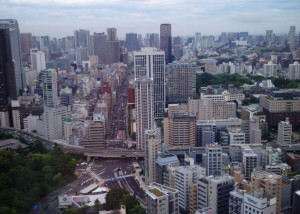
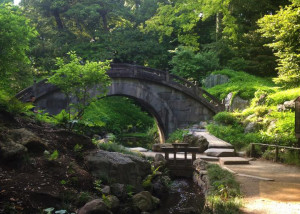
Left: The Tokyo skyline as seen from Tokyo Tower contrasted with Right: A serene bridge inside Koishikawa Korakuen, a traditional Japanese garden in Tokyo.
Through my Environmental History course, we studied the effect of environmental issues on Japanese culture and history over time. During my time in Japan, we interacted with many people, from university students to filmmakers, non-profit organizations, and even government officials at a waste processing site, all with the purpose of learning about the environmental issues. During the program, we moved to and from the countryside, meeting guides who taught us about the unique history and traditions of the places we visited and highlighted the longstanding relationship with the environment, both its great beauty and the effects of devastating pollution and disasters. We explored the harmony and disharmony between humans and nature.
Left: A pastoral scene found while hiking in Nikko, Japan. Right: Basking in the beauty of Lake Chuzenji from a swan boat.
Back to Performance
When looking at the description for UMS’s upcoming presentation of Sankai Juku’s UMUSUNA: Memories Before History, I think about hiking in ancient, old growth forest in the “sea of trees” at the base of Mt. Fuji. My class was spending the weekend in Fujinomiya, Japan at the Whole Earth Nature School, an organization that facilitates groups in “ecotourism.” Our guides, Michi and Musashi, stressed the importance of engaging with the environment, so while we learned about Mt. Fuji as an active volcano and this history of the plant growth form observation, we got dirty, hugged a few trees, and went caving as well.
I’m not sure that we could have been prepared for the ice in the cave. Everything from the floor to walls to ceiling was covered with a thick layer of ice. We tried to avoid it but conceded to sitting down and sliding throughout. It was a challenging experience. We tried our best to work as a team to identify those least icy parts. When we reached a clearing in the cave, we turned off our head lamps and sat in darkness, deep below the earth we had once stood on. Climbing out of the cave, we moved from darkness to light and the most vivid colors I’d ever seen. I won’t forget both the reverence I felt in that cave and the joy upon reaching the surface.
Butoh performance, like Sankai Juku’s UMUSUNA: Memories Before History, which plays at the Power Center this October, often aren’t narrative. The symbolism of their intense movement vocabulary is left for the audience to decipher. I expect this performance will call to my mind my experiences both in the forests of Mt. Fuji and elsewhere, experiences that attempted to illuminate the complex relationship between Japanese culture and the environment. We interacted, even climbed inside, the earth. We wondered what it would have been like before human interaction—a history we can only imagine.
Interested in more? From our archives, backstage with Sankai Juku.
Dialogue with Gravity: 10 Things You Didn’t Know About Butoh

Photo: A moment from UMUSUNA: Memories Before History, a Butoh-inspired work by the Japanese company Sankai Juku, who perform in Ann Arbor October 23-24, 2015. Photo courtesy of the artist.
1. ‘Bu’ means ‘to dance’ and ‘toh’ means ‘to stamp the ground.’ (Via)
2. Butoh was originally the name of a ritual dance performed by peasants celebrating the harvest. Stamping the ground would trap a divinity in the ground, which would in turn lead to a good crop. (Via)
3. Art movements are often molded and pushed into being by tragic and disastrous events, and butoh is no exception. Now, the term butoh generally refers to the revolutionary Japanese dance movement spurred by the horrors of World War II.
4. The inventors Tatsumi Hijikata and Kazuo Ohno were looking for a new form of Japanese dance that did not use Western techniques. The first performances of butoh were so wild and provocative that the style and performances were banned. (Via)
5. This butoh has elements of existentialism, surrealism, German expressionism, Japanese kabuki theater, and Eastern spiritual thought. (Via)
6. Some butoh is referred to as a “dance of darkness” and often uses taboo, grotesque subject matter. Other butoh focuses on the more ridiculous and laughable aspects of the human condition. (Via)

Photo: Another moment from UMUSUNA: Memories Before History by Sankai Juku. Photo courtesy of the artist.
7. In addition to gaping mouths and mesmerizingly slow movements, two other signature characteristics of the form are shaved heads and the use of white powder to cover the dancers’ bodies. It’s still hotly contested why these practices originated the form. However, the impact is clear; through hiding dancers’ differentiating features, the attention of the audience is drawn to the dancers’ movements. (Via)
8. Unlike many Western dances, butoh says that the dance is already laying dormant in the dancer’s body as an “inner landscape.” To realize the dance, the dancer has to pull together personal experiences, memories, and habits. As a result, some butoh dances do not involve specific forms and movements as their basic element. (Via)
9. According to Amagatsu, the director of Sankai Juku, butoh represents a “dialogue with gravity.” Most dance forms, on the other hand, “revel in the escape from gravity.” That is, the aim of butoh is to play with perception of time and space through slowing down and synchronizing with gravity.
10. Butoh has already had several different generations of dancers who have made changes to the art form. Because butoh tends to rely on its dancers’ individual bodies, revivals of butoh compositions can be difficult. Sankai Juku is innovative in part because the company standardized repertoire so that movement could be repeated from performance to performance. In the past, butoh works often “lived and died in a single performance.” (Via)
Interested in more? From our archives, backstage with Sankai Juku.
UMS Arts Roundup: October 22
Many members of the UMS staff keep a watchful eye on local and national media for news about artists on our season, pressing arts issues, and more. Each week, we pull together a list of interesting stories and share them with you. Welcome to UMS’s Arts Round-up, a weekly collection of arts news, including national issues, artist updates, local shout-outs, and a link or two just for fun. If you come across something interesting in your own reading, please feel free to share!
Arts Issues
- 25-year-old Yulianna Avdeeva of Russia won the 2010 International Frederic Chopin Piano Competition, the first woman to win in 45 years…but the award did not come without controversy.
Artist Updates
- Sankai Juku just wrapped up their 2-week-run at the Joyce Theater in New York–see the Huffington Post review here.
- People are Watching: Our staff’s favorite video this week is this stunning clip of Hibiki by Sankai Juku.
- Need to get your jazz fix? Check out two clips from the Hot Club of Detroit’s new release here and here.
- Meet Vijay Iyer: last week’s feature on NPR’s Fresh Air.
- Dig into the music: New York Times Magazine interviews Arvo Pärt, whose music appears on the Tallis Scholars’ upcoming concert.
UMS News
- AnnArbor.com preview of Sankai Juku‘s Power Center performances this weekend.
- AnnArbor.com preview of the Venice Baroque Orchestra and Robert McDuffie, featuring Vivaldi’s “Four Seasons” and Glass’s “American Four Seasons” concerti next Wednesday’s performance.
- AnnArbor.com review of the Jerusalem Quartet concert.
Local Shout-Outs
- Follow tenor Nicholas Phan, U-M School of Music alum, Ann Arbor native, and a soloist in this season’s Messiah, on his way to his Carnegie Hall debut.
Just For Fun
- Where will he be in 20 years, let alone 10? Watch 3-year-old Jonathan conduct Beethoven in his living room!
- Something’s Rotten in the State of Facebook…an NPR spoof on Hamlet.
UMS’s Arts Roundup: October 8
Many members of the UMS staff keep a watchful eye on local and national media for news about artists on our season, pressing arts issues, and more. Each week, we pull together a list of interesting stories and share them with you. Welcome to UMS’s Arts Round-up, a weekly collection of arts news, including national issues, artist updates, local shout-outs, and a link or two just for fun. If you come across something interesting in your own reading, please feel free to share!
Arts Issues
- The DSO isn’t the only performing arts organization in financial trouble. The Dutch government has proposed closing the Netherlands Broadcasting Music Center, dismantling the Netherlands Radio Philharmonic, Netherlands Radio Chamber Philharmonic, Metrople Orchestra, and the Netherlands Radio Choir.
Artist Updates
- Time has run out at 3711 Woodward Ave, and the musicians of the Detroit Symphony Orchestra are on strike.
- The Metropolitan Opera opens fifth season of live high-def broadcasts this weekend with Wagner’s Das Rheingold.
- Riccardo Muti cancels his fall Chicago Symphony appearances due to illness, but violinist Anne-Sophie Mutter was up to the task, directing the season-opening Symphony Ball.
UMS News
- Barbara Hoover of The Detroit News and Susan Nisbett of Ann Arbor.com offer a glimpse at this weekend’s Paul Taylor performances
- And the AnnArbor.com review of Thursday night’s opening performance appeared this morning.
- Valergy Gergiev and the orchestra formerly known as the Kirov (now the Mariinsky) visit Ann Arbor on Sunday with a program of Rachmaninoff and Mahler.
- Japanese butoh troupe Sankai Juku, appearing as part of the UMS dance season in late October, opened their residency at New York City’s Joyce Theater this week.
- Murray Perahia cancels fall tour (including Nov 10 UMS concert) due to hand problems; Vladimir Feltsman takes his place with program of Mozart, Schubert and Chopin
- Takacs Quartet Schubert Concert: AnnArbor.com preview, Kahane out, Feltsman in (again!) for Schubert’s last piano sonata.
Local Shout-Outs
- This is the last weekend to head west to see Grand Rapids’ ArtPrize finalists. The winner of the $250,000 top prize was announced yesterday!
Just For Fun
- Think dance is just for the world’s clubs and stages? Check out this choreographed in-flight safety demonstration by Cebu Pacific. Look out Southwest, somebody’s trying to up the fun quotient!
20th Annual Dance Series Announced
The University Musical Society is pleased to announce its 20th Annual Dance Series, with five companies performing in the Power Center and the Detroit Opera House. The series includes:
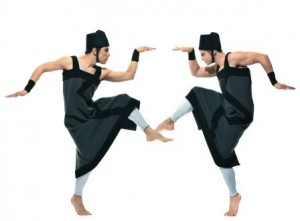 Paul Taylor Dance Company
Paul Taylor Dance Company
Paul Taylor, artistic director
Thursday, October 7 | 8 pm
Friday, October 8 | 8 pm
Saturday, October 9 | 8 pm
Power Center
More than a half-century ago, after performing in the companies of Merce Cunningham, Martha Graham, and George Balanchine, Paul Taylor became the youngest member of the pantheon that created American modern dance. Now approaching 80 — an age when most artists’ best work is behind them — Taylor is acclaimed for the vibrancy, relevance, and power of his dances. As prolific as ever, he continues to offer cogent observations on life’s complexities while tackling some of society’s thorniest issues. While his work has largely been iconoclastic, since the very start of his career Taylor has also made some of the most purely romantic, most astonishingly athletic, and downright funniest dances ever put on a stage. UMS, in collaboration with the U-M Department of Dance, shines a light on Paul Taylor, with a day-long residency and three performances highlighting just a fraction of the more than 130 dances he has created. “What other artist today makes poetic drama of such variety and eloquence? A Taylor season is a journey through one of the most singular and searching imaginations of our time.” (The New York Times, 2/17/10)
Program (Thurs 10/7)
Speaking in Tongues (Music by Matthew Patton) (1988)
Esplanade (J.S. Bach) (1975)
Program (Fri 10/8)
Orbs (Ludwig van Beethoven) (1966)
Also Playing (Gaetano Donizetti) (2009)
Program (Sat 10/9)
Black Tuesday (Songs of the Great Depression) (2001)
The Word (David Israel) (1998)
Piazzolla Caldera (Astor Piazzolla and Jerzy Peterburshsky) (1997)
Sankai Juku: Hibiki
Ushio Amagatsu, director, choreographer, and designer
Saturday, October 23 | 8 pm
Sunday, October 24 | 2 pm
Power Center
Ushio Amagatsu, the founder and artistic director of Sankai Juku, trained in classical as well as modern dance before he devoted his life to butoh. Butoh first appeared in Japan after World War II and is often defined by its playful and grotesque imagery, taboo topics, and absurd environments. Traditionally performed in white body makeup with slow, hyper-controlled, mesmerizing motion, butoh represents to Amagatsu a “dialogue with gravity,” whereas most dance forms revel in the escape from gravity. It plays with the perception of time and space through slowing down the experience — the dance equivalent of haiku, only much longer. The company last appeared in Ann Arbor in 1999. In 2002, the work that they will perform, Hibiki – Resonance From Far Away, received an Olivier Award for “Best New Dance Production.” “[Ushio Amagatsu] conveys the infinitely minute yet spellbinding transformations of a world in constant metamorphosis.” (Dance Magazine)
Grupo Corpo
Rodrigo and Paulo Pederneiras, artistic director and choreographer
Friday, January 21 | 8 pm
Saturday, January 22 | 8 pm
Power Center
This electrifying Brazilian dance company captivates with stunning, sexy physicality, dynamic ability, and rich visual flair. Grupo Corpo (literally “Body Group”) creates a vibrant and seamless blend of ballet’s grace, modern dance’s verve, and the hip-swiveling exuberance of Carnival sambas and their Afro-Brazilian roots. Founded in 1975, Grupo Corpo returns to Ann Arbor — the company appeared in 2002 as part of UMS’s focus on Brazilian artists — with two performances featuring Ímã (2009) and another work to be announced. Don’t miss this chance to experience Grupo Corpo’s “searing sensuality elegantly under control.” (Le Monde, Paris)
Merce Cunningham Dance Company
Friday, February 18 | 8 pm
Saturday, February 19 | 8 pm
Power Center
When the always forward-thinking Merce Cunningham passed away in July 2009 at the age of 90, he left behind a plan for the dissolution of his dance company and the preservation of his works: a two-year legacy tour that would end on December 31, 2011 with a performance in New York City. Cunningham was undeniably a leader of the American avant-garde throughout his 70-year career and is considered one of the most important choreographers of our time. Through much of his life, he was also one of the greatest American dancers, performing with the Martha Dance Company for six years. With an artistic career distinguished by constant innovation, Cunningham expanded the frontiers of dance, but also of contemporary visual and performing arts. His collaborations with artistic innovators from every creative discipline have yielded an unparalleled body of American dance, music, and visual art. These two different programs will be drawn from the more than 150 dances that Cunningham created over more than six decades of choreographic innovation. In Merce’s own words: “You have to love dancing to stick to it. It gives you nothing back, no manuscripts to store away, no paintings to show on walls and maybe hang in museums, no poems to be printed and sold, nothing but that single fleeting moment when you feel alive.” Fleeting for the dancer, perhaps, but creating lasting impressions for the audiences that experience it.
Alvin Ailey American Dance Theater
Judith Jamison, artistic director
Thursday, March 3 | 7:30 pm [note start time!]
Detroit Opera House
UMS is partnering with the Detroit Opera House so that UMS dance subscribers can experience this quintessentially American dance company. The Alvin Ailey American Dance Theater grew from the now-fabled performance in March 1958 at the 92nd Street Young Men’s Hebrew Association in New York. Led by Alvin Ailey and group of young African-American modern dancers, that performance forever changed the perception of American dance. Now, some 52 years later, the company has performed for an estimated 23 million people in 48 states and 71 countries on six continents. The company has earned a reputation as one of the most acclaimed international ambassadors of American culture, promoting the uniqueness of the African-American cultural experience and the preservation and enrichment of the American modern dance heritage. When Alvin Ailey began creating dance, he drew upon his “blood memories” of Texas, the blues, spirituals, and gospel as inspiration, which resulted in the creation of his most popular and critically-acclaimed work, Revelations.
This performance is only available to dance subscribers; all other tickets will be sold through the Detroit Opera House. UMS will offer round-trip luxury coach service to Detroit for this performance for those who prefer not to drive (details to be announced).
Tickets for the five-performance series range from $133-$206. Subscription renewal packets and brochures will be mailed in early May.
Tickets to individual events on the series go on sale on Monday, August 23 (via www.ums.org) and Wednesday, August 25 (in person and by phone).



